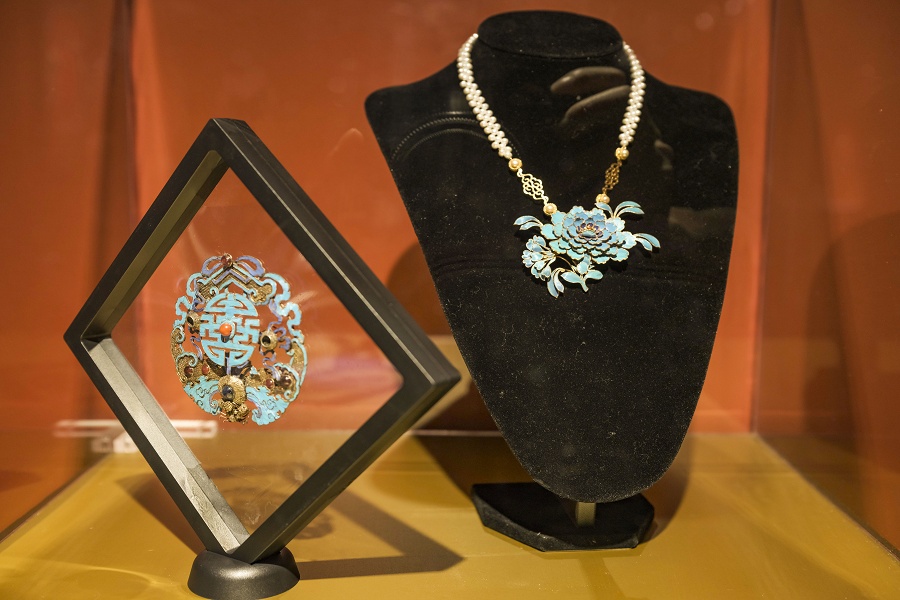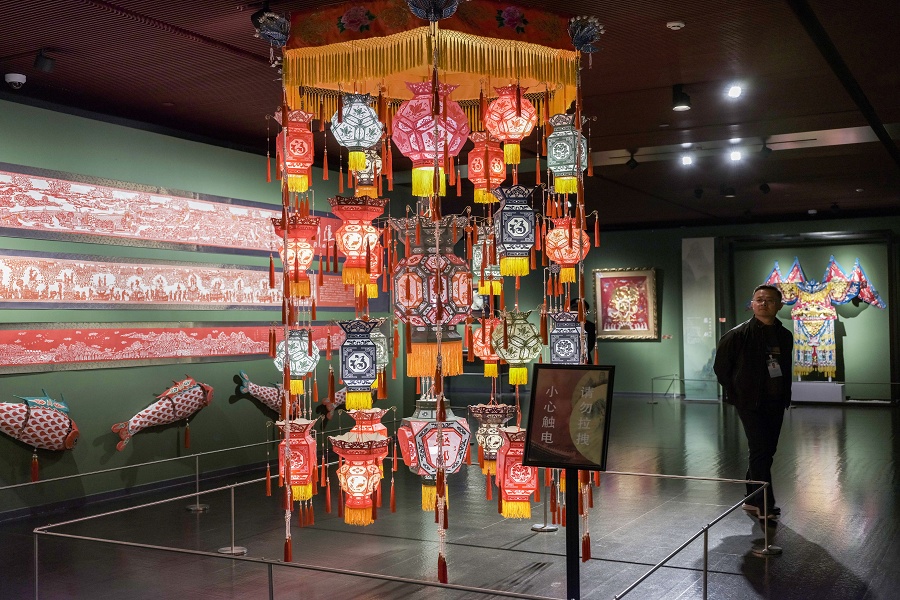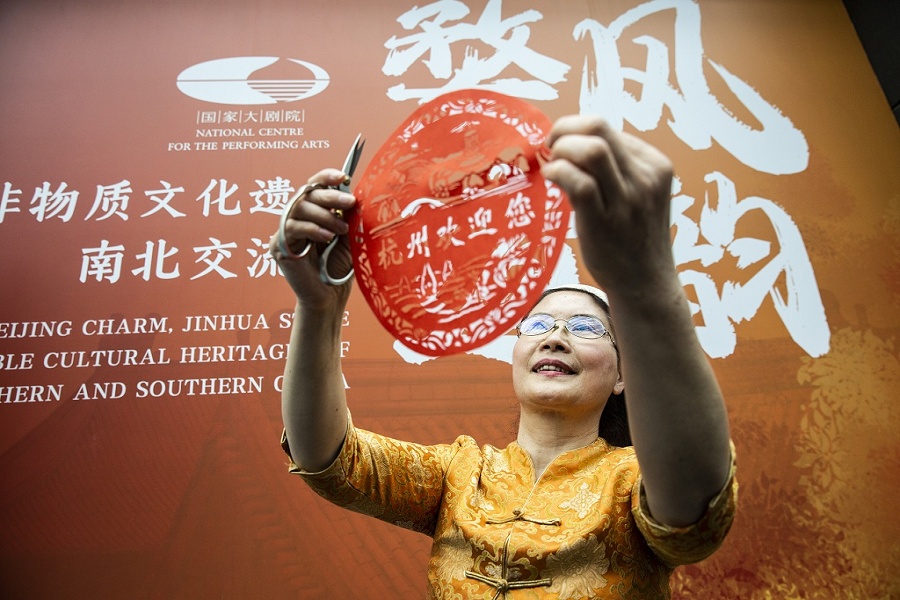From Court to Crowd

“We are seeing intangible cultural heritage penetrate Chinese people’s lives and shape their lifestyles, behavior patterns, and philosophies,” said co-curator Yang Xuechen when she was touring around the exhibition hall. The exhibition “Beijing Charm, Jinhua Style—Intangible Cultural Heritages of Northern and Southern China” at the National Center for the Performing Arts (NCPA) displayed over 220 pieces (sets) of handicrafts in 30 categories from the cities of Beijing and Jinhua, both boasting rich cultural heritage.
The exhibition was divided into three parts: Royal Classics in Beijing, Song Dynasty Legacies in Jinhua, and Blending Southern and Northern Styles.
Royal Classics
After serving as the capital city of five dynasties lasting over 1,000 years, Beijing boasts abundant royal cultural heritage featuring supreme craftsmanship and precious materials. Among them, the “eight most famous representatives” are cloisonné, jade carving, ivory carving, lacquer carving, lacquerware inlaid with silver, gold and jewelry, filigree jewelry, royal carpet, and Beijing embroidery.
“These items used to be reserved for royal families,” said Yang, who is also deputy director of the Arts Museum Department of NCPA. “But now the public can also enjoy these exquisite craftworks.”
Back in the old times, no fresh fruits or vegetables were available in winter even for emperors living in the Forbidden City, now known as the Palace Museum. So, eye-relishing ornaments in shapes of vegetables and fruits became popular among the rich and powerful. This was how the Chang family became famous. In the Qing Dynasty (1644-1911), the Chang family began to make decorative glass products. A bunch of frosted glass grapes the family made were so lifelike that many visitors believed they were real. The traditional technique used to make glass ornaments has been passed down across seven generations in the family. “We have been constantly brainstorming ways to make new breakthroughs on the skills since the times have changed,” said Chang Hong, a current inheritor of the technique. “This exhibition is a good chance for us to show our skills and pool more ideas about innovation from the public.”

Longevity (left), a Beijing cloisonné work, and a brooch made with the same technique.
Song Legacies
Due to its proximity to Lin’an (now Hangzhou in eastern China’s Zhejiang Province), the capital city of the Southern Song Dynasty (1127-1279), Jinhua was heavily influenced by the Song culture, which is characterized by inclusiveness, literati customs, and diverse schools of thought.
“Contrasting Beijing’s cultural heritage, Jinhua’s output focused more on daily use, was enjoyed by the public, and leveraged indigenous materials,” noted Yang. For instance, the costumes of Peking Opera performed in the imperial palace were usually decorated with luxury trimmings like gold or silver threads, while Wu (ancient name of Jinhua) Opera’s costumes were made of silk, a specialty fabric in southern China. “Wu Opera’s costumes were brighter and more colorful because the stages were often far from the audience,” Yang continued. “The audience in the imperial palace could get close to the stage, so Peking Opera’s costumes were magnificent but with more modest colors.”
A “calling card” of Jinhua, Dongyang wood carving was listed as a national intangible cultural heritage item in 2006. The traditional craft tends to keep the original textures of the wood and boasts multi-layer patterns which are concise but not simple, and grand but not extravagant. Wheat-straw clipart and paper cutting in Pujiang District of Jinhua both developed from local folk arts. Locals used to make wheat-straw hats and fans and gradually began to design screens and other ornaments. Pujiang paper cutting also evolved from a tradition to an art form. “When I got married, I had to put paper-cutting works on everything in my dowry to show villagers how skilled I was,” said Zhu Ruifang, an inheritor of Pujiang paper cutting. “Now, the custom is not so popular, but paper cutting is preserved as a handicraft passed down from generation to generation.” According to Zhu, Pujiang paper cutting mostly features figures from local operas. “The distinctive characteristic of our paper cutting is that we don’t cut out the facial features of the figures, but you can still sense their facial expression,” she said. “In recent years, more and more young people have joined us. They open studios and often have new ideas which have injected new vigor into this old craft.”

Boneless lanterns made by acupuncture tools, a representative intangible cultural heritage in Dongyang City, Zhejiang Province.
Blending Styles
The Beijing-Hangzhou Grand Canal, the longest of its kind in the world, was first constructed in the late Spring and Autumn Period (770-476 B.C.) and successively expanded during the Sui (581-618) and Yuan (1271-1368) dynasties.
The canal starts in Hangzhou, capital of Zhejiang Province, in the south and reaches Beijing in the north, spanning over 1,797 kilometers. Throughout its history of more than 2,500 years, the canal has played a key role in cultural and economic communication and exchange between China’s north and south. Thanks to the canal, Jinhua and Beijing had more opportunities to borrow from each other. Many artworks and craftworks from Jinhua were sent to Beijing as tributes, such as Dongyang wood carving and Wu porcelain. Gradually, Beijing’s craftsmen merged those skills, patterns, and ingredients into their own cultural products, creating a combined style with traits of both sides.
Traditional tea processing techniques and associated social practices in China were inscribed on the Representative List of the Intangible Cultural Heritage of Humanity in 2022. Beijing’s flower tea and Jinhua’s green tea were included. “The two places are famous for different categories of tea and tea-making skills,” said Yang. “Through tea ceremonies, they share common social etiquette, respect for nature, and love for life.”

An inheritor of paper-cutting techniques displays a work themed on the Hangzhou Asian Games.